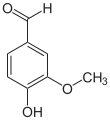Vanillin
| |||

| |||
| Names | |||
|---|---|---|---|
| Preferred IUPAC name
4-Hydroxy-3-methoxybenzaldehyde | |||
| Other names | |||
| Identifiers | |||
3D model (
JSmol ) |
|||
| 3DMet | |||
| 472792 | |||
| ChEBI | |||
| ChEMBL | |||
| ChemSpider | |||
ECHA InfoCard
|
100.004.060 | ||
| EC Number |
| ||
| 3596 | |||
IUPHAR/BPS |
|||
| KEGG | |||
| MeSH | vanillin | ||
PubChem CID
|
|||
RTECS number
|
| ||
| UNII | |||
CompTox Dashboard (EPA)
|
|||
| |||
| |||
| Properties | |||
| C8H8O3 | |||
| Molar mass | 152.149 g·mol−1 | ||
| Appearance | White crystals | ||
| Odor | Vanilla, sweet, balsamic, pleasant | ||
| Density | 1.056 g/cm3[3] | ||
| Melting point | 81 °C (178 °F; 354 K)[3] | ||
| Boiling point | 285 °C (545 °F; 558 K)[3] | ||
| 10 g/L | |||
| log P | 1.208 | ||
| Vapor pressure | >1 Pa | ||
| Acidity (pKa) | 7.781 | ||
| Basicity (pKb) | 6.216 | ||
| Structure | |||
| Monoclinic | |||
| Thermochemistry | |||
Std enthalpy of (ΔcH⦵298)combustion |
−3.828 MJ/mol | ||
| Hazards | |||
| GHS labelling: | |||

| |||
| Warning | |||
| H302, H317, H319 | |||
| P280, P305+P351+P338 | |||
| NFPA 704 (fire diamond) | |||
| Flash point | 147 °C (297 °F; 420 K) | ||
| Safety data sheet (SDS) | ICSC 1740 | ||
| Related compounds | |||
Related compounds
|
|||
Except where otherwise noted, data are given for materials in their standard state (at 25 °C [77 °F], 100 kPa).
| |||
Vanillin is an
Vanillin and ethylvanillin are used by the food industry; ethylvanillin is more expensive, but has a stronger note. It differs from vanillin by having an ethoxy group (−O−CH2CH3) instead of a methoxy group (−O−CH3).
Natural vanilla extract is a mixture of several hundred different compounds in addition to vanillin. Artificial vanilla flavoring is often a solution of pure vanillin, usually of synthetic origin. Because of the scarcity and expense of natural vanilla extract, synthetic preparation of its predominant component has long been of interest. The first commercial synthesis of vanillin began with the more readily available natural compound eugenol (4-allyl-2-methoxyphenol). Today, artificial vanillin is made either from guaiacol or lignin.

Lignin-based artificial vanilla flavoring is alleged to have a richer flavor profile than that from guiacol-based artificial vanilla; the difference is due to the presence of
History
Although it is generally accepted that vanilla was domesticated in
Vanilla beans, called tlilxochitl, were discovered and cultivated as a flavoring for beverages by native Mesoamerican peoples, most famously the Totonacs of modern-day Veracruz, Mexico. Since at least the early 15th century, the Aztecs used vanilla as a flavoring for chocolate in drinks called xocohotl.[7]
Vanillin was first isolated as a relatively pure substance in 1858 by Théodore Nicolas Gobley, who obtained it by evaporating a vanilla extract to dryness and recrystallizing the resulting solids from hot water.[8] In 1874, the German scientists Ferdinand Tiemann and Wilhelm Haarmann deduced its chemical structure, at the same time finding a synthesis for vanillin from coniferin, a glucoside of isoeugenol found in pine bark.[9] Tiemann and Haarmann founded a company Haarmann and Reimer (now part of Symrise) and started the first industrial production of vanillin using their process (now known as the Reimer–Tiemann reaction) in Holzminden, Germany. In 1876, Karl Reimer synthesized vanillin (2) from guaiacol (1).[10]

By the late 19th century, semisynthetic vanillin derived from the eugenol found in
Synthetic vanillin became significantly more available in the 1930s, when production from clove oil was supplanted by production from the
Beginning in 2000,
Occurrence

Vanillin is most prominent as the principal flavor and aroma compound in vanilla. Cured vanilla pods contain about 2% by dry weight vanillin. On cured pods of high quality, relatively pure vanillin may be visible as a white dust or "frost" on the exterior of the pod.
It is also found in Leptotes bicolor, a species of orchid native to Paraguay and southern Brazil,[17] and the Southern Chinese red pine.
At lower concentrations, vanillin contributes to the flavor and aroma profiles of foodstuffs as diverse as olive oil,[18] butter,[19] raspberry,[20] and lychee[21] fruits.
Aging in
In other foods, heat treatment generates vanillin from other compounds. In this way, vanillin contributes to the flavor and aroma of
Chemistry
Natural production
Natural vanillin is extracted from the seed pods of Vanilla planifolia, a vining orchid native to Mexico, but now grown in tropical areas around the globe. Madagascar is presently the largest producer of natural vanillin.
As harvested, the green seed pods contain vanillin in the form of its β-D-glucoside; the green pods do not have the flavor or odor of vanilla.[29]

After being harvested, their flavor is developed by a months-long curing process, the details of which vary among vanilla-producing regions, but in broad terms it proceeds as follows:
First, the seed pods are blanched in hot water, to arrest the processes of the living plant tissues. Then, for 1–2 weeks, the pods are alternately sunned and sweated: during the day they are laid out in the sun, and each night wrapped in cloth and packed in airtight boxes to sweat. During this process, the pods become dark brown, and enzymes in the pod release vanillin as the free molecule. Finally, the pods are dried and further aged for several months, during which time their flavors further develop. Several methods have been described for curing vanilla in days rather than months, although they have not been widely developed in the natural vanilla industry,[30] with its focus on producing a premium product by established methods, rather than on innovations that might alter the product's flavor profile.
Biosynthesis

Although the exact route of vanillin biosynthesis in V. planifolia is currently unknown, several pathways are proposed for its biosynthesis. Vanillin biosynthesis is generally agreed to be part of the
Chemical synthesis
The demand for vanilla flavoring has long exceeded the supply of vanilla beans. As of 2001[update], the annual demand for vanillin was 12,000 tons, but only 1,800 tons of natural vanillin were produced.
At present, the most significant of these is the two-step process practiced by Rhodia since the 1970s, in which guaiacol (1) reacts with glyoxylic acid by electrophilic aromatic substitution.[36] The resulting vanillylmandelic acid (2) is then converted by 4-Hydroxy-3-methoxyphenylglyoxylic acid (3) to vanillin (4) by oxidative decarboxylation.[14]
Wood-based vanillin
15% of the world's production of vanillin is produced from lignosulfonates, a byproduct from the manufacture of cellulose via the sulfite process.[12][13] The sole producer of wood-based vanillin is the company Borregaard located in Sarpsborg, Norway.
Wood-based vanillin is produced by copper-catalyzed oxidation of the lignin structures in lignosulfonates under alkaline conditions[37] and is claimed by the manufacturing company to be preferred by their customers due to, among other reasons, its much lower carbon footprint than petrochemically synthesized vanillin.
Fermentation
The company Evolva has developed a genetically modified microorganism which can produce vanillin. Because the microbe is a processing aid, the resulting vanillin would not fall under U.S. GMO labeling requirements, and because the production is nonpetrochemical, food using the ingredient can claim to contain "no artificial ingredients".[38]
Using ferulic acid as an input and a specific non GMO species of Amycolatopsis bacteria, natural vanillin can be produced.
Biochemistry
Several studies have suggested that vanillin can affect the performance of
Uses

The largest use of vanillin is as a flavoring, usually in
Vanillin is also used in the fragrance industry, in perfumes, and to mask unpleasant odors or tastes in medicines, livestock fodder, and cleaning products.[14] It is also used in the flavor industry, as a very important key note for many different flavors, especially creamy profiles such as cream soda.
Additionally, vanillin can be used as a general-purpose stain for visualizing spots on thin-layer chromatography plates. This stain yields a range of colors for these different components.
Vanillin–HCl staining can be used to visualize the localisation of tannins in cells.
Vanillin is becoming a popular choice for the development of bio-based plastics.[42]
Manufacturing
Vanillin has been used as a chemical intermediate in the production of
Adverse effects
Vanillin can trigger
Some people have
Vanilla orchid plants can trigger contact dermatitis, especially among people working in the vanilla trade if they come into contact with the plant's sap.[47] An allergic contact dermatitis called vanillism produces swelling and redness, and sometimes other symptoms.[47] The sap of most species of vanilla orchid which exudes from cut stems or where beans are harvested can cause moderate to severe dermatitis if it comes in contact with bare skin. The sap of vanilla orchids contains calcium oxalate crystals, which are thought to be the main causative agent of contact dermatitis in vanilla plantation workers.[48][49]
A
Ecology
See also
- Phenolic compounds in wine
- Other positional isomers:
- Benzaldehyde
- Protocatechuic aldehyde
- Syringaldehyde
References
- Blank, Imre; Alina Sen; Werner Grosch (1992). "Potent odorants of the roasted powder and brew of Arabica coffee". Zeitschrift für Lebensmittel-Untersuchung und -Forschung A. 195 (3): 239–245. S2CID 67845142.
- Bjørsvik, Hans-René; Minisci, Franscesco (1999). "Fine Chemicals from Lignosulfonates. 1. Synthesis of Vanillin by Oxidation of Lignosulfonates". Org. Process Res. Dev. 3 (5): 330–340. .
- Brenes, Manuel; Aranzazu García; Pedro García; José J. Rios; Antonio Garrido (1999). "Phenolic Compounds in Spanish Olive Oils". Journal of Agricultural and Food Chemistry. 47 (9): 3535–3540. PMID 10552681.
- Buttery, Ron G.; Louisa C. Ling (1995). "Volatile Flavor Components of Corn Tortillas and Related Products". Journal of Agricultural and Food Chemistry. 43 (7): 1878–1882. .
- Dignum, Mark J. W.; Josef Kerlera; Rob Verpoorte (2001). "Vanilla Production: Technological, Chemical, and Biosynthetic Aspects". Food Reviews International. 17 (2): 119–120. S2CID 84296900. Retrieved 2006-09-09.
- Esposito, Lawrence J.; K. Formanek; G. Kientz; F. Mauger; V. Maureaux; G. Robert; F. Truchet (1997). "Vanillin". Kirk-Othmer Encyclopedia of Chemical Technology, 4th edition. Vol. 24. New York: John Wiley & Sons. pp. 812–825. ISBN 978-0-471-52693-3.
- Fache, Maxence; Boutevin, Bernard; Caillol, Sylvain (2015). "Vanillin Production from Lignin and Its Use as a Renewable Chemical". ACS Sustain. Chem. Eng. 4 (1): 35–46. .
- Fund for Research into Industrial Development, Growth and Equity (FRIDGE) (2004). Study into the Establishment of an Aroma and Fragrance Fine Chemicals Value Chain in South Africa, Part Three: Aroma Chemicals Derived from Petrochemical Feedstocks. National Economic Development and Labor Council. Archived from the original on 2007-09-30. Retrieved 2017-07-08.
- Gobley, M. (1858). "Recherches sur le principe odorant de la vanille". Journal de Pharmacie et de Chimie. 34: 401–405.
- Guth, Helmut; Werner Grosch (1995). "Odorants of extrusion products of oat meal: Changes during storage". Zeitschrift für Lebensmittel-Untersuchung und -Forschung A. 196 (1): 22–28. S2CID 82716730.
- Hocking, Martin B. (September 1997). "Vanillin: Synthetic Flavoring from Spent Sulfite Liquor" (PDF). Journal of Chemical Education. 74 (9): 1055–1059. . Retrieved 2006-09-09.
- Kermasha, S.; M. Goetghebeur; J. Dumont (1995). "Determination of Phenolic Compound Profiles in Maple Products by High-Performance Liquid Chromatography". Journal of Agricultural and Food Chemistry. 43 (3): 708–716. .
- Lampman, Gary M.; Jennifer Andrews; Wayne Bratz; Otto Hanssen; Kenneth Kelley; Dana Perry; Anthony Ridgeway (1977). "Preparation of vanillin from eugenol and sawdust". Journal of Chemical Education. 54 (12): 776–778. .
- Ong, Peter K. C.; Terry E. Acree (1998). "Gas Chromatography/Olfactory Analysis of Lychee (Litchi chinesis Sonn.)". Journal of Agricultural and Food Chemistry. 46 (6): 2282–2286. .
- Reimer, Karl Ludwig (1876). "Ueber eine neue Bildungsweise aromatischer Aldehyde". Berichte der Deutschen Chemischen Gesellschaft. 9 (1): 423–424. .
- Roberts, Deborah D.; Terry E. Acree (1996). "Effects of Heating and Cream Addition on Fresh Raspberry Aroma Using a Retronasal Aroma Simulator and Gas Chromatography Olfactometry". Journal of Agricultural and Food Chemistry. 44 (12): 3919–3925. .
- Rouhi, A. Maureen (2003). "Fine Chemicals Firms Enable Flavor And Fragrance Industry". Chemical and Engineering News. 81 (28): 54.
- Tiemann, Ferd.; Wilh. Haarmann (1874). "Ueber das Coniferin und seine Umwandlung in das aromatische Princip der Vanille". Berichte der Deutschen Chemischen Gesellschaft. 7 (1): 608–623. .
- Van Ness, J. H. (1983). "Vanillin". Kirk-Othmer Encyclopedia of Chemical Technology, 3rd edition. Vol. 23. New York: John Wiley & Sons. pp. 704–717. ISBN 978-0-471-02076-9.
- Viriot, Carole; Augustin Scalbert; Catherine Lapierre; Michel Moutounet (1993). "Ellagitannins and lignins in aging of spirits in oak barrels". Journal of Agricultural and Food Chemistry. 41 (11): 1872–1879. .
- Vreuls, René J. J.; van der Heijden, Arnold; Brinkman, Udo A. Th.; Adahchour, Mohamed (1999). "Trace-level determination of polar flavour compounds in butter by solid-phase extraction and gas chromatography–mass spectrometry". Journal of Chromatography A. 844 (1–2): 295–305. PMID 10399332.
- Walton, Nicholas J.; Melinda J. Mayer; Arjan Narbad (July 2003). "Vanillin". PMID 12809710.
Notes
- ^ a b Field, Simon Quellen. "Vanillin". sci-toys.com.
- ^ CID 1183 from PubChem.
- ^ ISBN 978-1-4987-5429-3.
- ^ According to Esposito 1997, blind taste-testing panels cannot distinguish between the flavors of synthetic vanillin from lignin and those from guaicol, but can distinguish the odors of these two types of synthetic vanilla extracts. Guaiacol vanillin, adulterated with acetovanillone, has an odor indistinguishable from lignin vanillin.
- S2CID 181608839.
- ^ PMID 35349581.
- ^ MexicanVanilla.com. "Mexican Vanilla - A History". MexicanVanilla.com. Retrieved 2022-06-14.
- ^ Gobley 1858.
- ^ Tiemann 1874.
- ^ Reimer 1876.
- ^ According to Hocking 1997, synthetic vanillin was sold commercially in 1874, the same year Tiemann and Haarmann's original synthesis was published. Haarmann and Reimer, one of the corporate ancestors of the modern flavor and aroma manufacturer Symrise, was in fact established in 1874. However, Esposito 1997 claims that synthetic vanillin first became available in 1894 when Rhône-Poulenc (since 1998, Rhodia) entered the vanillin business. If the former claim is correct, the authors of the latter article, being employees of Rhône-Poulenc, may have been unaware of any previous vanillin manufacture.
- ^ a b c d e Hocking 1997.
- ^ a b Fache et al 2015
- ^ a b c Esposito 1997.
- ^ Kamlet, Jonas & Mathieson, Olin (1953). Manufacture of vanillin and its homologues U.S. Patent 2,640,083 (PDF). U.S. Patent Office.
- ^ Rouhi 2003.
- ^ "Leptotes bicolor". Flora Library. Retrieved 2011-08-21.
- ^ Brenes 1999.
- ^ Adahchour 1999.
- ^ Roberts 1996.
- ^ Ong 1998.
- S2CID 91784893..
- ^ Viriot 1993.
- .
- ^ Blank 1992.
- ^ Kermasha 1995.
- ^ Buttery 1995.
- ^ Guth 1993.
- ^ a b Walton 2003.
- ^ Dignum 2001 reviews several such proposed innovations in vanilla processing, including processes in which the seed pods are chopped, frozen, warmed by a heat source other than the sun, or crushed and treated by various enzymes. Whether or not these procedures produce a product whose taste is comparable to traditionally prepared natural vanilla, many of them are incompatible with the customs of the natural vanilla market, in which the vanilla beans are sold whole, and graded by, among other factors, their length.
- ^ Dixon, R. A. (2014). "Vanillin Biosynthesis – Not as simple as it seems?" (PDF). Handbook of Vanilla Science and Technology: 292.
- ^ PMID 24941968.
- ^ Dignum 2001.
- ^ Hocking 1997. This chemical process can be conveniently carried out on the laboratory scale using the procedure described by Lampman 1977.
- ^ Van Ness 1983.
- PMID 32189791.
- ^ Bjørsvik and Minisci 1999
- ^ Bomgardner, Melody M. (2016-09-14). "The Problem with Vanilla". Scientific American. Retrieved 2020-10-19.
- PMID 29973719.
- PMID 29107747.
- ^ FRIDGE 2004, p. 33.
- .
- S2CID 37559260.
- ^ "Global Vanillin Market Research Report – Industry Analysis, Size, Share, Growth, Trends and Forecast 2015–2022". PRNewsire. 14 September 2016. Retrieved 18 February 2017.
- PMID 9082382.
- ^ A. H. van Assendelft, "Adverse drug reactions checklist" in the British Medical Journal, February 28th, 1987, pp. 576–577.
- ^ ISBN 978-1-55009-378-0.
- ^ "Vanilla planifolia Andrews - Plants of the World Online - Kew Science". powo.science.kew.org. Archived from the original on 22 November 2017.
- ^ "Vanillin". Plants for a Future. Archived from the original on 1 December 2017.
- .




